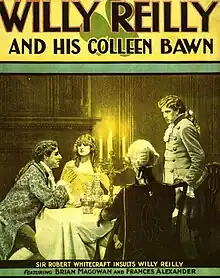Willy Reilly and his Colleen Bawn
Willy Reilly and his Colleen Bawn is a 1920 silent film adaptation of William Carleton's 1855 novel Willy Reilly and his dear Colleen Bawn made by the Film Company of Ireland. Brian Magowan, Frances Alexander and Richard Sheridan starred in the film. It is one of few films by the FCOI that remain in substantially complete form.[1][2] John MacDonagh, the brother of Thomas MacDonagh, a signatory of the Proclamation of the Irish Republic in 1916, was the films director and played Tom the Fool under the pseudonym Richard Sheridan. The film concerns religious tolerance and the "triumph of love across the sectarian divide."[3]
| Willy Reilly and his Colleen Bawn | |
|---|---|
 | |
| Directed by | John MacDonagh |
| Based on | Willy Reilly and his dear Colleen Bawn by William Carleton |
| Produced by | James Mark Sullivan |
| Starring | Brian Magowan Frances Alexander John MacDonagh Seamus MacBlante Dermot O'Dowd Barrett McDonnell |
Production company | |
| Distributed by | Film Company of Ireland |
Release dates |
|
| Language | English |
Plot
The film is set in 18th-century County Cavan during the Penal laws. A Catholic landowner, Willy Reilly, falls in love with Helen Folliard (the Colleen Bawn), the daughter of a Protestant Squire,[4] after being invited to his home for saving him from Red Rapparee. Reilly is required to convert if he wishes to marry into the family, with his father favoring another suitor, Sir Robert Whitecraft, a persecutor of Catholics. Willy Reilly refuses to convert. Sir Robert soon enlists the help of Red Rapparee, telling him he wishes to see Reilly in Sligo Jail and conspires a plan with the goal of Reilly's imprisonment. Reilly soon becomes a fugitive of the law and is harbored by a Protestant clergyman, Rev. Brown, who offers because he "abhor[s] persecution" and for the "fact that" they "are fellow-Irishmen". Rev. Brown and Mr. Hastings report the actions of Sir Robert, who burned down Reilly's manor that had the ownership transferred to Mr. Hastings, to the Lord-lieutenant. The Lord-lieutenant issues a warrant for Sir Roberts arrest. Reilly eventually returns disguised as a peasant and becomes a gardener for Squire Folliard. Reilly and the Colleen Bawn elope soon after Reilly's true identity is discovered. Reilly and the Colleen Bawn are caught. Helen's is returned to her father, who promises her to Sir Robert, with the wedding abandoned the day of when Sir Robert is found to be an arsonist and murderer. Reilly is charged with theft and abduction, but eventually found guilty only of abduction. He is exiled for seven years. Afterwards, Helen remains wistful until she is reunited with Reilly and her father accepts their relationship despite their different religions.
Cast
- Brian Magowan as Willy Reilly
- Frances Alexander as Helen Folliard/The Colleen Bawn
- John MacDonagh as Tom the Fool (credited as Richard Sheridan)
- Seamus MacBlante as Sir Robert Whitecraft
- Dermot O'Dowd as Squire Folliard
- Barrett McDonnell as Red Rapparee
Production
Willy Reilly and his Colleen Bawn was filmed on 35 mm,[5] and it was produced by James Mark Sullivan. It was directed by John MacDonagh, the brother of Thomas MacDonagh.[6] Filming took place in 1919.[7] John MacDonagh left for Scotland immediately following the end of production in order to evade arrest.[8] Some portions were filmed at the St. Enda's School, which is now the site of the Pearse Museum.[2] The film has seven reels.[9]
Release
The film premiered at Manchester's Free Trade Hall on 5 January, 1920.[8] It was first shown in Ireland in Dublin on 19 April, 1920.[1][9] The film was released during the Irish War of Independence.[8]
References
- Condon, Denis (14 June 2017). "Early Irish Cinema: A New Industry: The Film Company of Ireland's First Season". Film Ireland Magazine. Retrieved 26 June 2020.
- "IFI presents a Pre-Tour Dress Rehearsal of 'Willy Reilly and His Colleen Bawn'". filmIreland. 21 May 2013. Retrieved 18 September 2023.
- "Willy Reilly and His Colleen Bawn (1920) - Pre-Tour Dress Rehearsal". Irish Film Institute.
- "Willy Reilly and His Colleen Bawn". MUBI.
- "Willy Reilly and His Colleen Bawn (1918) - Technical specifications" – via IMDb.
- "John McDonagh - Commentary". The National Archives of Ireland.
- "Willie Reilly and His Colleen Bawn". Silent Era. Retrieved September 7, 2023.
- "The MacDonagh brothers – a rich artistic legacy". The Irish Times. February 20, 2023. Retrieved September 20, 2023.
- "Was England the "Most Fruitful Ground" to Show the Irish Film Willy Reilly and His Colleen Bawn in 1920?". Early Irish Cinema. July 30, 2020. Retrieved September 7, 2023.